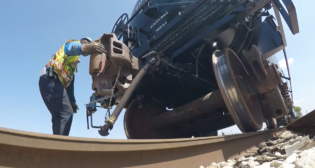
New from NSC: High-capacity cottonseed/woodchip gondolas
Written by William C. Vantuono, Editor-in-ChiefNational Steel Car (NSC) and Curry Rail Services of Hollidaysburg, Pa., have teamed up to build new, high-capacity gondolas for cottonseed and woodchip service.
These cars have a GRL (gross rail load) of 286,000 pounds and payload of 106.5 tons, with a level cubic capacity of 7,200 cubic feet. In contrast, the current fleet of cottonseed cars is basically comprised of 600 ex-woodchip gondolas. These are 263,000-pound GRL, 6,800-cubic-foot capacity with a 94- to 95-ton per-car payload.
 NSC’s current production involves cars built for Chickasha of Georgia LLC, a cottonseed cooperative owned by several southeastern gins. Chickasha provides gins and cottonseed processors with logistics management services, and processes cottonseed into feed pellets, delinted cottonseed and linters. Its cottonseed products are used for feeding livestock, and its linters are used as premium-quality cellulose.
NSC’s current production involves cars built for Chickasha of Georgia LLC, a cottonseed cooperative owned by several southeastern gins. Chickasha provides gins and cottonseed processors with logistics management services, and processes cottonseed into feed pellets, delinted cottonseed and linters. Its cottonseed products are used for feeding livestock, and its linters are used as premium-quality cellulose.
These new cars are equipped with dual-hinged ends, and doors that swing open from the end top chord. They can also be built with fixed ends and rotary dump capability.
“Cottonseed by rail is a relatively new opportunity that has proven timely during a declining rail woodchip market,” says NSC Senior Vice President Marketing and Sales Bob Pickel. “These new cars replace aging, lower-capacity woodchip cars for both woodchip and cottonseed services. We believe that the replacement market for old cars requires a minimum 7,000-cubic-feet-plus-capacity car with a 210,000-pound (105-ton) payload, and LOPF (length over pulling face) not to exceed 68 to 69.5 feet. There are some height restrictions as well, but COG (center of gravity) seems to be the controlling element of car design. Also, existing cars are heaped and tarped, and may exceed current COG limits. We feel that market demand may be 500 or more cars, as the aging fleet must be retired.”
The market, notes Pickel, “has apparently changed. The railroads have improved their velocity, thus reducing the number of cars required to move the same amount of product, with some estimates as high as a 20% improvement. This equates to moving product in 4 cars instead of 5, with previous velocity. However, it should be noted that velocity changes are generally short-term, so equipment planners should plan for slowest velocity to protect revenue loads.”
NSC’s efforts to market new, high-capacity woodchip/cottonseed gondolas have had limited success, with few purchase and considerable “sitting on the fence activity, or inactivity, to better describe the situation,” says Pickel. “We considered a strategy to promote new cars, especially for cottonseed traffic, and looked to move existing older cars from cottonseed service to woodchip service. This strategy makes sense for a number of reasons.
“Cottonseed moves for long distances, such as Georgia and Texas to the West Coast and Pacific Northwest. This traffic would benefit from new, higher-capacity gons—106 tons vs. 95 tons payload—a 12% improvement that goes directly to the bottom line, since freight rates are per-car for most traffic.
“Existing cars are literally on their last legs, with high maintenance costs. Long-haul cottonseed service is very taxing on this old equipment, with fallout and non-repair a common factor. The current 600-car fleet likely will decrease significantly over the next year and beyond.
Existing cars are designed to meet interline service and thus have only a few years of interchange life remaining. They are more attractive to woodchip service where service is less demanding and shorter-haul. The woodchip by rail market is likely single-line and more receptive to waivers of interchange requirements that would allow use of existing older cars.
New railcar prices are very low and likely to increase over the next year and beyond, so prospective buyers should consider acquiring cars now to take advantage of this situation.
“The cottonseed market can economically absorb higher fr
eight and equipment costs (be it ownership or lease), whereas the woodchip market is far more sensitive to these factors. Hence, new cars have a better chance of acceptance in cottonseed service.
“Market feedback indicated that new car prices and attendant lease rates are too high, even for cottonseed service. What is an acceptable price/lease rate?
Cottonseed is also shipped in 60-foot boxcars, but traditional woodchip gondolas are now being used to transport cottonseed. “This is a rather recent phenomenon, since woodchips by rail have become increasingly uneconomical, while cottonseed production has disappeared from California, which is a major consumer of this product,” Pickel notes “Thus, California requires cottonseed as a feedstock for its vast agricultural/cattle markets. Other major cottonseed-consuming areas include states with large hoofed agricultural animals. Cottonseed is also a prime export commodity, usually by container. Georgia and Texas are major producers of cottonseed. Texas is also a major consumer, but its proximity to cottonseed limits movement by rail for that market.”



